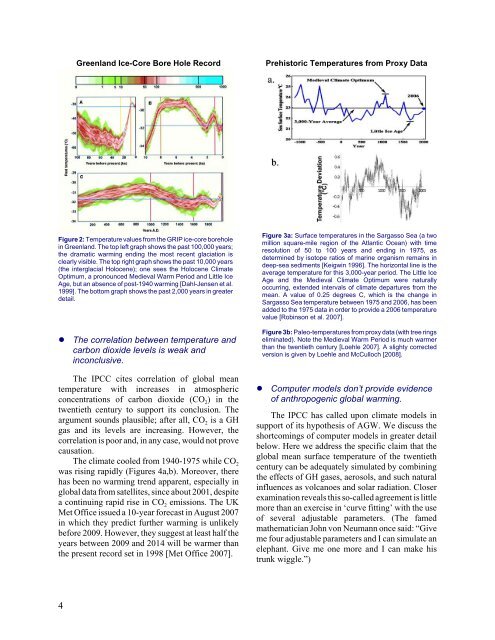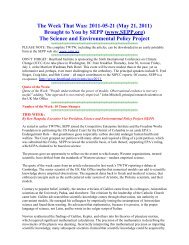Nature, Not Human Activity, Rules the Climate - Science ...
Nature, Not Human Activity, Rules the Climate - Science ...
Nature, Not Human Activity, Rules the Climate - Science ...
Create successful ePaper yourself
Turn your PDF publications into a flip-book with our unique Google optimized e-Paper software.
Greenland Ice-Core Bore Hole RecordPrehistoric Temperatures from Proxy DataFigure 2: Temperature values from <strong>the</strong> GRIP ice-core boreholein Greenland. The top left graph shows <strong>the</strong> past 100,000 years;<strong>the</strong> dramatic warming ending <strong>the</strong> most recent glaciation isclearly visible. The top right graph shows <strong>the</strong> past 10,000 years(<strong>the</strong> interglacial Holocene); one sees <strong>the</strong> Holocene <strong>Climate</strong>Optimum, a pronounced Medieval Warm Period and Little IceAge, but an absence of post-1940 warming [Dahl-Jensen et al.1999]. The bottom graph shows <strong>the</strong> past 2,000 years in greaterdetail.! The correlation between temperature andcarbon dioxide levels is weak andinconclusive.The IPCC cites correlation of global meantemperature with increases in atmosphericconcentrations of carbon dioxide (CO 2 ) in <strong>the</strong>twentieth century to support its conclusion. Theargument sounds plausible; after all, CO 2 is a GHgas and its levels are increasing. However, <strong>the</strong>correlation is poor and, in any case, would not provecausation.The climate cooled from 1940-1975 while CO 2was rising rapidly (Figures 4a,b). Moreover, <strong>the</strong>rehas been no warming trend apparent, especially inglobal data from satellites, since about 2001, despitea continuing rapid rise in CO 2 emissions. The UKMet Office issued a 10-year forecast in August 2007in which <strong>the</strong>y predict fur<strong>the</strong>r warming is unlikelybefore 2009. However, <strong>the</strong>y suggest at least half <strong>the</strong>years between 2009 and 2014 will be warmer than<strong>the</strong> present record set in 1998 [Met Office 2007].Figure 3a: Surface temperatures in <strong>the</strong> Sargasso Sea (a twomillion square-mile region of <strong>the</strong> Atlantic Ocean) with timeresolution of 50 to 100 years and ending in 1975, asdetermined by isotope ratios of marine organism remains indeep-sea sediments [Keigwin 1996]. The horizontal line is <strong>the</strong>average temperature for this 3,000-year period. The Little IceAge and <strong>the</strong> Medieval <strong>Climate</strong> Optimum were naturallyoccurring, extended intervals of climate departures from <strong>the</strong>mean. A value of 0.25 degrees C, which is <strong>the</strong> change inSargasso Sea temperature between 1975 and 2006, has beenadded to <strong>the</strong> 1975 data in order to provide a 2006 temperaturevalue [Robinson et al. 2007].Figure 3b: Paleo-temperatures from proxy data (with tree ringseliminated). <strong>Not</strong>e <strong>the</strong> Medieval Warm Period is much warmerthan <strong>the</strong> twentieth century [Loehle 2007]. A slighty correctedversion is given by Loehle and McCulloch [2008].! Computer models don’t provide evidenceof anthropogenic global warming.The IPCC has called upon climate models insupport of its hypo<strong>the</strong>sis of AGW. We discuss <strong>the</strong>shortcomings of computer models in greater detailbelow. Here we address <strong>the</strong> specific claim that <strong>the</strong>global mean surface temperature of <strong>the</strong> twentiethcentury can be adequately simulated by combining<strong>the</strong> effects of GH gases, aerosols, and such naturalinfluences as volcanoes and solar radiation. Closerexamination reveals this so-called agreement is littlemore than an exercise in ‘curve fitting’ with <strong>the</strong> useof several adjustable parameters. (The famedma<strong>the</strong>matician John von Neumann once said: “Giveme four adjustable parameters and I can simulate anelephant. Give me one more and I can make histrunk wiggle.”)4





